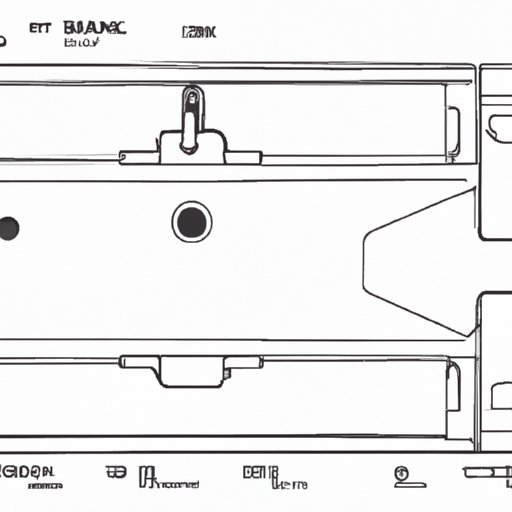Overview of Standard Kitchen Sink Dimensions
When it comes to remodeling or building a new kitchen, one of the most important decisions to make is selecting the right size kitchen sink. After all, the kitchen sink is an essential part of any kitchen and can be used for washing dishes, prepping food, and more. So, what is the standard size of a kitchen sink?
The answer depends on several factors, such as the type of kitchen sink you choose, the size of your kitchen, and the design of your kitchen space. Generally speaking, kitchen sinks come in a variety of sizes, from small single-basin sinks to large double-basin sinks.
Types of Kitchen Sinks
Kitchen sinks are available in a range of materials, such as stainless steel, porcelain, composite granite, and cast iron. However, the most popular material is stainless steel, which is durable and easy to clean.
When it comes to style, there are two main types of kitchen sinks: single-basin and double-basin. Single-basin sinks feature one large basin, while double-basin sinks have two separate basins. Each basin can be used for different tasks, such as washing dishes in one and rinsing fruits and vegetables in the other.

Average Dimensions of Standard Kitchen Sinks
The average dimensions of standard kitchen sinks vary depending on the type of sink you choose. Single-basin sinks typically measure 22 to 33 inches wide and 24 to 32 inches deep. Double-basin sinks usually measure 33 to 48 inches wide and 24 to 32 inches deep.
Keep in mind that these measurements are just averages, and the exact dimensions may differ slightly depending on the manufacturer. It’s also important to note that some kitchen sinks are available in larger sizes, such as 36 to 48 inches wide and 24 to 32 inches deep.

A Guide to Kitchen Sink Size Selection
When selecting a kitchen sink, it’s important to consider several factors, such as the size of your kitchen, the layout of your kitchen, and your budget. You should also take into account any existing features, such as cabinets, countertops, and appliances.
It’s also important to think about how you will use the sink. Do you need a large sink for washing large pots and pans? Or do you prefer a smaller sink for quick and easy cleaning? Your needs and preferences should help guide your decision.
How to Decide Which Size is Right for You
Once you’ve considered the factors mentioned above, it’s time to decide which size kitchen sink is right for you. If you’re not sure which size to get, it’s best to measure your kitchen space before making a purchase. This will help ensure that the sink you choose fits perfectly in your kitchen.
How to Measure for the Right Kitchen Sink Size
Measuring your kitchen space for the right kitchen sink size is simple and straightforward. First, measure the length and width of the area where the sink will be installed. Then, measure the height of the cabinet or countertop that the sink will sit on. Finally, measure the distance between the cabinet or countertop and the wall or any other nearby objects.
Once you have the measurements, compare them to the dimensions of the kitchen sink you’re considering. Make sure that the sink will fit in the allotted space without any issues. If the measurements don’t match up, you may need to look for a different size sink.
It’s also important to keep in mind that some kitchen sinks require additional space for installation. For example, if you’re installing a double-basin sink, you’ll need extra space to accommodate both basins. Make sure to factor this into your measurements.

Popular Kitchen Sink Dimensions: Pros and Cons
Now that you know how to measure for the right kitchen sink size, let’s take a look at the pros and cons of two of the most popular kitchen sink dimensions: single-basin and double-basin sinks.
Single-Basin Sinks
Single-basin sinks are ideal for small kitchens, as they don’t take up much space. They also tend to be less expensive than double-basin sinks. The downside is that they don’t offer as much versatility, as there is only one basin for washing and rinsing.
Double-Basin Sinks
Double-basin sinks are perfect for larger kitchens, as they provide ample space for washing and rinsing. They also offer more versatility, as each basin can be used for different tasks. The downside is that they can be more expensive than single-basin sinks.
The Benefits of a Standard-Size Kitchen Sink
Having a standard-size kitchen sink has many advantages. For one, it makes installation easier, as standard-size sinks fit most kitchen spaces. Plus, standard-size sinks tend to be more cost-effective than custom-sized sinks.
Another benefit of having a standard-size sink is that it offers more storage options. Standard-size sinks can easily fit into existing cabinets and countertops, so you won’t have to buy new ones. This can save you money in the long run.
Conclusion
Selecting the right size kitchen sink is essential when remodeling or building a new kitchen. The standard size of a kitchen sink varies depending on the type and style of sink, as well as the size of your kitchen. When deciding which size sink is right for you, it’s important to consider the layout of your kitchen, the size of the space, and your budget. Measuring your kitchen space is also essential, as it will help ensure that the sink you choose fits perfectly in your kitchen.
Standard-size kitchen sinks offer many benefits, such as easier installation, more cost-effectiveness, and increased storage options. With careful consideration and accurate measurements, you can easily find the perfect kitchen sink for your needs.


